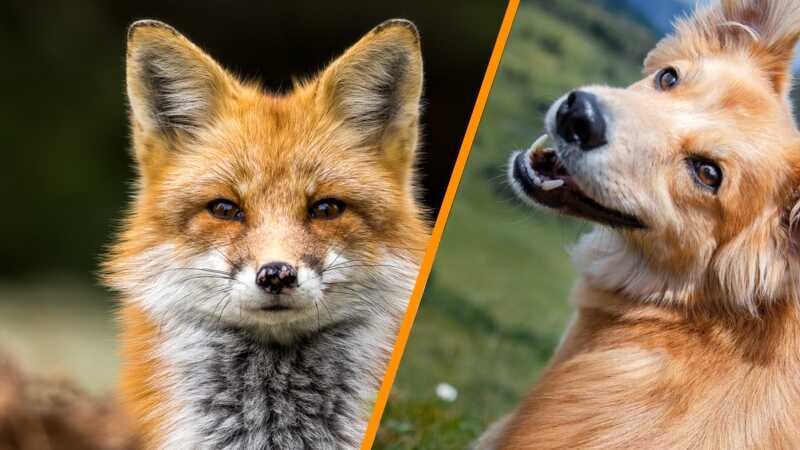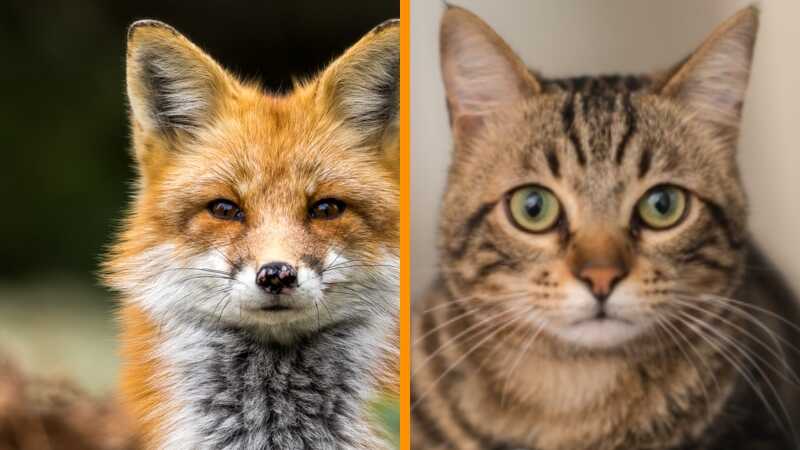Imagine foxes as charming and delightful little bundles of fur – creatures you might wish were tamed enough by now in human history to coexist with us in our homes.
Regardless, it’s highly likely that you’ve briefly considered whether they belong to the cat or dog category. I’ve pondered this as well.
Frankly, it’s a valid query because foxes strongly resemble both families, fitting in seamlessly with either one.
Therefore, the question arises: Are foxes closer to dogs or cats? Furthermore, what attributes contribute to their likeness to both, despite being exclusively one of these biologically?
Let’s delve into the explanations.
Are Foxes Closer to Dogs or Cats?
The distinction regarding whether foxes are biologically categorized as cats or dogs is quite straightforward: they fall under the canidae family, classifying them as dogs.

The term “Canidae” starts from the Latin word “Canis,” which deciphers to “pooch.” Wikipedia highlights that this creature family includes “residential pooches, wolves, coyotes, foxes, jackals, dingoes, and other existing and terminated dog-like warm blooded creatures.”
The offspring of foxes are known as kits, cubs, or pups. Male foxes are denoted as tods or reynards, while females are called vixens. Are you feeling perplexed? Perhaps you initially believed that foxes belonged to the cat family but can’t pinpoint why you held that assumption.
It is interesting that foxes and cats look and act similarly. First, let’s look at the similar physical characteristics between these two animals. Then, we can talk about the things they both have in common behaviorally.
Similarities & Differences Between Foxes and Dogs

Evolution and Taxonomy
Both foxes and dogs come from the same family, which means they have a shared ancestor through evolution. However, they split into different types and kinds over many years.
Foxes evolved into their species around 7 million years ago, while dogs evolved from wolves through domestication.
Anatomy and Traits
- Snouts and Sense of Smell: Foxes and dogs possess snouts that house a keen sense of smell. This trait is crucial for hunting and survival, especially for foxes in the wild.
- Large Ears: According to a study in 2020, both species have prominent, upright ears that enhance their hearing. This adaptation aids in detecting prey and potential threats.
- Tails and Communication: Foxes and dogs use their tails to communicate emotions and states, such as alertness, fear, and arousal.
Omnivorous Diet
- Omnivores: Despite the misconception that they are solely carnivores, both foxes and dogs are omnivores. They require a combination of meat and vegetation for a balanced diet.
- Nutrient Requirements: Foxes have specific dietary needs, such as taurine, which is essential for their health. Unlike dogs, foxes cannot naturally produce taurine and must obtain it from animal tissues. This nutrient deficiency in foxes’ diets can lead to serious health issues.
Habitat and Behavior
- Domestication: Dogs have undergone a long history of domestication, adapting to life alongside humans. They have been successfully housebroken and integrated into human households.
- Domestication Challenges with Foxes: Domesticating foxes is more challenging, and housebreaking them is often difficult. Despite ongoing experiments, foxes remain closer to their wild nature than dogs.
Reproductive Incompatibility
While both animals share anatomical features, their genetic differences prevent successful interbreeding. Foxes and dogs have distinct chromosome arrangements due to their separate evolutionary paths, making it unlikely for them to produce offspring.
Dietary Adaptations
- Red Fox Diet: Red foxes primarily consume small mammals and incorporate select fruits and vegetables.
- Arctic Fox Diet: Cold foxes have adjusted to their cold situations and devour angle, infant seals, and ocean growth for their salt substance
Similarities & Differences Between Foxes and Cats

Evolutionary Background and Similarities in Behavior
While foxes and cats are not closely related, they share several behavioral traits due to their similar ecological niches.
Both animals are meat-eating mammals that have developed to be very good at hunting. They act like normal animals when hunting by quietly approaching their prey, pouncing on them, and trying not to be seen.
Sensory Adaptations
Both foxes and cats have evolved with keen senses that aid in their nocturnal hunting. Their eyes have thin, vertical pupils that help them control how much light comes into their eyes. This helps them see better in places with not a lot of light.
Additionally, both species possess a reflective layer called the tapetum lucidum behind their retinas, enhancing their night vision.
Hunting Techniques
Foxes and cats exhibit similar hunting techniques, such as using stealth and patience to ambush their prey. They regularly utilize front paws to hold down prey whereas conveying a deadly nibble. This strategy contrasts with the dog’s chasing fashion, which is chasing and shaking their prey.
Purring and Social Behavior
Foxes can emit a purr-like noise, especially when excited. While not as pronounced as a cat’s purr, this behavior displays their capacity for expressing positive emotions.
Additionally, contrary to their former solitary tendencies, many foxes demonstrate social behavior when raised in captivity or domesticated settings.
Hybrid Behaviors
Foxes can exhibit a mix of behaviors, displaying both dog-like and cat-like tendencies. This half-breed behavior highlights the flexibility of these creatures to different situations and circumstances.
Domestication and Human Interaction
Cats have been tamed for a long time – thousands of years. In differentiation to foxes, residential cats have been specifically bred to create assortments with special qualities.
Due to their long-standing fellowship with individuals, cats’ connections with people as often as possible vary from those of foxes.
FAQs
Do foxes make hissing sounds?
Yes, foxes can produce a variety of vocalizations, and hissing is one of them. While they are not as well-known for hissing as other animals like snakes or cats, foxes can indeed hiss, especially when they feel threatened or are in distress.
Do foxes produce barking sounds similar to dogs?
Yes, foxes can produce barking sounds similar to those of dogs. However, fox barks tend to be higher-pitched and shrill than most domestic dogs’ deeper barks. Woofing is a communication that foxes utilize as often as possible to communicate with other foxes in their region.
Is a fox classified as a member of the canine family?
Yes, foxes are classified as canine family members, scientifically known as Canidae. Its family is up of several animals like domestic dogs, wolves, coyotes, and other canids in the wild. Foxes are like other pooches in numerous ways regarding how they see and act.
Conclusion
In conclusion, we answered the question, Are foxes closer to dogs or cats?
Although foxes have some similarities with dogs and cats, they are more genetically similar to dogs. Their physical features, like their bones and some actions, are more similar to dogs.
It is worth recognizing that foxes have a few comparable characteristics to cats, like their retractable claws and behavior. In simple words, foxes are more like dogs than cats because their ancestors and genes are similar to dogs.
Recommended Reading



























